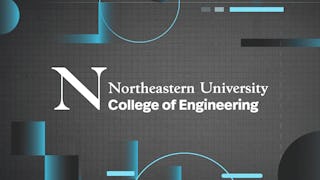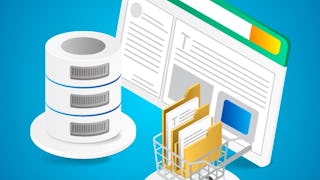This course introduces the fundamental concepts and emerging technologies in database design and modeling, database systems, data storage, and data governance. It presents a balanced theory-practice focus and covers entity relationship model and UML model, relational model, relational databases, Structured Query Language, and two flavors of NoSQL databases in MongoDB and Neo4j graph database. It also includes a brief introduction to big data management including hadoop, MapReduce, and Apache Spark. This course provides the theory and applications of database management to support data analytics, data mining, machine learning, and artificial intelligence.

Fin demain. Donnez un coup de fouet à votre carrière en bénéficiant de 40 % de réduction sur les cours d'Adobe, d'IBM et d'autres. Économisez maintenant.


Compétences que vous acquerrez
- Catégorie : MongoDB
- Catégorie : Database Design
- Catégorie : Conceptual Design
- Catégorie : Database Systems
- Catégorie : Big Data
- Catégorie : Apache Hadoop
- Catégorie : Apache Spark
- Catégorie : Data Modeling
- Catégorie : NoSQL
- Catégorie : Data Storage Technologies
- Catégorie : Database Theory
- Catégorie : Database Management Systems
- Catégorie : Unified Modeling Language
- Catégorie : Database Architecture and Administration
Détails à connaître

Ajouter à votre profil LinkedIn
8 devoirs
Découvrez comment les employés des entreprises prestigieuses maîtrisent des compétences recherchées

Il y a 4 modules dans ce cours
In this module, you'll explore the foundational principles of database management, focusing on the differences between file-based and database approaches to data management. You will learn about the key elements of a database system and the advantages of using database management systems (DBMS) to organize, store, and manipulate data. Through this module, you'll develop skills in database design and administration, gaining a deeper understanding of how DBMS enhances data management and supports professional work in fields like data analytics.
Inclus
3 vidéos7 lectures2 devoirs2 sujets de discussion
This module covers the architecture and categorization of Database Management Systems (DBMS). Here, you will learn the key components of DBMS architecture, including the query processor and storage manager, and how they interact to manage data. You will also learn to categorize DBMSs based on factors like data models, architecture, and usage, highlighting their characteristics and real-world applications. This module also provides resources and prompts for discussion to deepen understanding of DBMS types and their use cases in data management.
Inclus
5 lectures2 devoirs1 sujet de discussion
In this module, you'll explore the foundational steps of database design, focusing on conceptual data modeling using the Entity Relationship (ER) model. You will learn how to gather business requirements, identify key entity and relationship types, and develop a conceptual data model. This model serves as the blueprint for database design before transitioning to logical and physical designs. You'll also examine the limitations of the ER model and how to address them. By the end of this module, you will understand how to translate real-world business processes into a clear, organized conceptual data model.
Inclus
1 vidéo5 lectures2 devoirs
In this module we will learn three additional semantic data modeling concepts: specialization/generalization, categorization, and aggregation. These concepts enhance and extend the ER model discussed in the previous module. We will introduce an alternative conceptual model: the Unified Modeling Language (UML) class diagram. The UML is a modeling language that assists in the specification, visualization, construction, and documentation of artifacts of a software system. The UML can offer case diagrams, sequence diagrams, package diagrams, and deployment diagrams, etc. Here we use the UML for conceptual data modeling.
Inclus
1 vidéo6 lectures2 devoirs
Obtenez un certificat professionnel
Ajoutez ce titre à votre profil LinkedIn, à votre curriculum vitae ou à votre CV. Partagez-le sur les médias sociaux et dans votre évaluation des performances.
Instructeur

Offert par
En savoir plus sur Data Analysis


Northeastern University
 Statut : Essai gratuit
Statut : Essai gratuit
Illinois Tech
 Statut : Essai gratuit
Statut : Essai gratuit

Edureka
Pour quelles raisons les étudiants sur Coursera nous choisissent-ils pour leur carrière ?





Ouvrez de nouvelles portes avec Coursera Plus
Accès illimité à 10,000+ cours de niveau international, projets pratiques et programmes de certification prêts à l'emploi - tous inclus dans votre abonnement.
Faites progresser votre carrière avec un diplôme en ligne
Obtenez un diplôme auprès d’universités de renommée mondiale - 100 % en ligne
Rejoignez plus de 3 400 entreprises mondiales qui ont choisi Coursera pour les affaires
Améliorez les compétences de vos employés pour exceller dans l’économie numérique
Foire Aux Questions
Access to lectures and assignments depends on your type of enrollment. If you take a course in audit mode, you will be able to see most course materials for free. To access graded assignments and to earn a Certificate, you will need to purchase the Certificate experience, during or after your audit. If you don't see the audit option:
The course may not offer an audit option. You can try a Free Trial instead, or apply for Financial Aid.
The course may offer 'Full Course, No Certificate' instead. This option lets you see all course materials, submit required assessments, and get a final grade. This also means that you will not be able to purchase a Certificate experience.
When you purchase a Certificate you get access to all course materials, including graded assignments. Upon completing the course, your electronic Certificate will be added to your Accomplishments page - from there, you can print your Certificate or add it to your LinkedIn profile. If you only want to read and view the course content, you can audit the course for free.
You will be eligible for a full refund until two weeks after your payment date, or (for courses that have just launched) until two weeks after the first session of the course begins, whichever is later. You cannot receive a refund once you’ve earned a Course Certificate, even if you complete the course within the two-week refund period. See our full refund policy.
Plus de questions
Aide financière disponible,



